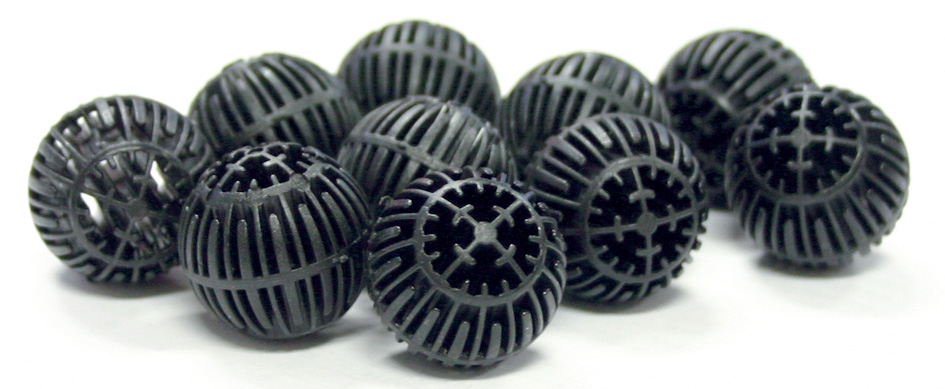Are you looking to improve the health of your pond or aquarium? Do you want to create a thriving aquatic ecosystem that is sustainable and low-maintenance? If so, then you need to consider using bio balls. In this comprehensive guide, we will explore everything you need to know about bio balls, including what they are, how they work, and why they are essential for maintaining a healthy aquatic environment.

Credit: aquariumscience.org
Table of Contents
ToggleWhat Are Bio Balls?
Bio balls are small, plastic, spherical filtration media that are commonly used in ponds and aquariums to provide biological filtration. They are designed to provide a large surface area for beneficial bacteria to colonize, which helps to break down harmful waste products such as ammonia and nitrites. Bio balls are typically used in conjunction with mechanical filtration media, such as filter pads or foam, to provide a comprehensive filtration system.
How Do Bio Balls Work?
Bio balls work by creating a hospitable environment for beneficial bacteria to thrive. These bacteria are essential for the nitrogen cycle, which is the process by which toxic ammonia and nitrites are converted into less harmful nitrates. As water passes through the bio balls, the bacteria colonize the surface of the media and break down the waste products, helping to maintain a healthy balance in the aquatic environment.

Credit: myaquaticsolutions.com
The Benefits of Using Bio Balls
There are several benefits to using bio balls in your pond or aquarium:
- Effective Biological Filtration: Bio balls provide a large surface area for beneficial bacteria to grow, resulting in efficient biological filtration.
- Low Maintenance: Once established, bio balls require minimal maintenance, making them a convenient option for busy pond or aquarium owners.
- Longevity: Bio balls are durable and can last for many years if properly cared for, providing long-term filtration benefits.
- Safe for Fish: Bio balls help to create a healthy environment for fish and other aquatic creatures by removing harmful waste products from the water.
How to Use Bio Balls
Using bio balls in your pond or aquarium is simple. Follow these steps to incorporate bio balls into your filtration system:
- Place the bio balls in a mesh bag or filter media tray.
- Position the bio balls in the biological filtration section of your filter system.
- Ensure that water flows evenly through the bio balls to maximize their effectiveness.
- Monitor the water quality regularly to ensure that the bio balls are functioning correctly.
- Clean the bio balls periodically by rinsing them in dechlorinated water to remove any debris or buildup.
Common Questions About Bio Balls
Here are some common questions that pond and aquarium owners have about bio balls:
1. Can Bio Balls Be Used In Saltwater Aquariums?
Yes, bio balls can be used in both freshwater and saltwater aquariums. They are versatile filtration media that are suitable for a wide range of aquatic environments.
2. How Many Bio Balls Do I Need For My Pond Or Aquarium?
The number of bio balls you need will depend on the size of your pond or aquarium and the stocking levels of fish or other aquatic creatures. As a general rule of thumb, aim for 1 gallon of bio balls per 100 gallons of water.
3. Do Bio Balls Need To Be Replaced?
With proper care and maintenance, bio balls can last for many years without needing to be replaced. However, if they become clogged or damaged, it may be necessary to replace them to maintain optimal filtration.
Frequently Asked Questions
What Are Bio Balls Used For?
Bio Balls are used in aquariums to provide surface area for beneficial bacteria to grow and aid in biological filtration.
How Do Bio Balls Help In Water Filtration?
Bio Balls help by promoting the growth of beneficial bacteria that break down harmful substances in water, improving water quality.
Are Bio Balls Safe For Freshwater Aquariums?
Yes, Bio Balls are safe for freshwater aquariums and can be used as an effective biological filtration media.
How Often Should Bio Balls Be Cleaned?
Clean Bio Balls every 1-2 months by rinsing them in aquarium water to remove debris without killing beneficial bacteria.
Conclusion
Bio balls are an essential component of any pond or aquarium filtration system. By providing effective biological filtration, low maintenance requirements, and long-lasting durability, bio balls offer a range of benefits for aquatic enthusiasts. Whether you are a beginner or experienced hobbyist, incorporating bio balls into your filtration setup can help you create a healthy and thriving aquatic environment for your fish and other aquatic creatures.
Remember, the key to success with bio balls is proper care and maintenance. Regular monitoring of water quality, routine cleaning, and replacement of damaged bio balls are all essential for ensuring optimal filtration performance. By following these guidelines and incorporating bio balls into your filtration system, you can enjoy a beautiful and sustainable aquatic ecosystem for years to come.
{ “@context”: “https://schema.org”, “@type”: “FAQPage”, “mainEntity”: [ { “@type”: “Question”, “name”: “What are Bio Balls used for?”, “acceptedAnswer”: { “@type”: “Answer”, “text”: “Bio Balls are used in aquariums to provide surface area for beneficial bacteria to grow and aid in biological filtration.” } } , { “@type”: “Question”, “name”: “How do Bio Balls help in water filtration?”, “acceptedAnswer”: { “@type”: “Answer”, “text”: “Bio Balls help by promoting the growth of beneficial bacteria that break down harmful substances in water, improving water quality.” } } , { “@type”: “Question”, “name”: “Are Bio Balls safe for freshwater aquariums?”, “acceptedAnswer”: { “@type”: “Answer”, “text”: “Yes, Bio Balls are safe for freshwater aquariums and can be used as an effective biological filtration media.” } } , { “@type”: “Question”, “name”: “How often should Bio Balls be cleaned?”, “acceptedAnswer”: { “@type”: “Answer”, “text”: “Clean Bio Balls every 1-2 months by rinsing them in aquarium water to remove debris without killing beneficial bacteria.” } } ] }